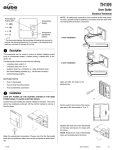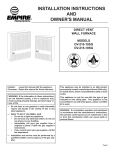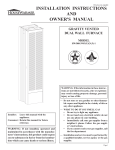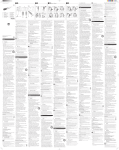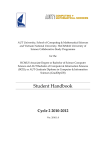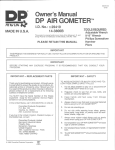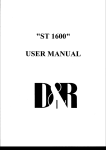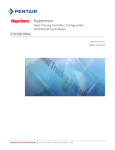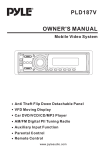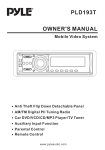Download Empire Comfort Systems DV-40E-5 Owner`s manual
Transcript
INSTALLATION INSTRUCTIONS AND OWNER'S MANUAL DIRECT VENT WALL FURNACE STANDARD MODELS: HWDV080DV(N,P)-1 HWDV181DV(N,P)-1 MODELS WITH BLOWER: HWDV080BDV(N,P)-1 HWDV181BDV(N,P)-1 GAS-FIRED Installer: Leave this manual with the appliance. Consumer: Retain this manual for future reference. WARNING: If the information in these instructions are not followed exactly, a fire or explosion may result causing property damage, personal injury or loss of life. — Do not store or use gasoline or other flammable vapors and liquids in the vicinity of this or any other appliance. — WHAT TO DO IF YOU SMELL GAS • Do not try to light any appliance. • Do not touch any electrical switch; do not use any phone in your building. • Immediately call your gas supplier from a neighbor’s phone. Follow the gas supplier’s instructions. • If you cannot reach your gas supplier, call the fire department. — Installation and service must be performed by a qualified installer, service agency or the gas supplier. This appliance may be installed in an aftermarket, permanently located, manufactured home (USA only), or mobile home, where not prohibited by state or local codes. This appliance is only for use with the type of gas indicated on the rating plate. This appliance is not convertible for use with other gases. WARNING: If not installed, operated, and maintained in accordance with the manufacturer's instructions, this product could expose you to substances in fuel or from fuel combustion which can cause death or serious illness. DO NOT RETURN THIS PRODUCT TO THE STORE WHERE YOU PURCHASED IT. IF YOU ARE MISSING PARTS, OR HAVE ANY PROBLEMS, CONTACT EMPIRE COMFORT SYSTEMS INC. AT (877) 459-1583. Page 1 TABLE OF CONTENTS SECTION PAGE Included in the Box .................................................................................................. 3 Hardware Packets .................................................................................................... 4 Tools Needed ............................................................................................................. 4 Gas Specifications .................................................................................................... 5 Specifications ............................................................................................................ 5 High Altitude Specifications .................................................................................... 5 Unit Dimensions ....................................................................................................... 6 Important Safety Information ................................................................................ 7 Safety Information for Users of LP-Gas ................................................................ 8 Introduction .............................................................................................................. 9 Requirements for Massachusetts .......................................................................... 10 Termination Clearances ......................................................................................... 11 Gas Supply ......................................................................................................... 12-13 Clearances ............................................................................................................... 13 Installation Instructions Overview ....................................................................... 14 Installation and Assembly ................................................................................ 15-16 Interior Preparation and Installation of the Back of the Unit ...................... 17-19 Interior Installation of the Front of the Unit ....................................................... 20 Cutting the Vent Tubes ..................................................................................... 21-22 Exterior Installation of the Venting ................................................................. 23-25 Reassembly and Resealing Vent-Air Intake System ...................................... 26-28 Installation of Optional Blower Kit HW125SCB ........................................... 29-32 Before Operating Appliance ............................................................................. 33-36 Operating Instructions .......................................................................................... 37 Lighting Instructions ............................................................................................. 38 To Turn Off Gas to Appliance ............................................................................... 38 Pilot Flame Characteristics ................................................................................... 39 Main Burner Flame Characteristics .................................................................... 39 Maintenance Instructions ...................................................................................... 40 Troubleshooting ...................................................................................................... 41 How To Order Repair Parts .................................................................................. 41 Parts List ............................................................................................................ 42-43 Parts View ............................................................................................................... 44 Service Notes ...................................................................................................... 45-47 Page 2 24632-0-0508 INCLUDED IN THE BOX DIRECT VENT HEATER (INSIDE WALL MOUNTING PLATE ATTACHED ON BACK) HEATER HARDWARE PACKET VENT SHIELD 24632-0-0508 INSTALLATION TEMPLATE (TEMPLATE FOR HWDV080 ON REVERSE SIDE) VENT KIT HARDWARE PACKET OUTSIDE WALL MOUNTING PLATE & VENT CAP INLET & OUTLET TUBES Page 3 HARDWARE PACKETS VENT KIT HARDWARE PACKET HEATER HARDWARE PACKET NYLON WASHER (2) #10 X ½” PHILLIPS HEX HEAD SCREW (3) PLASTIC TOGGLE (6) #10 X 2 ½” HEX HEAD SCREW (4) #10 X 1 ½” SLOTTED HEX HEAD SCREW (6) TOOLS NEEDED PHILLIPS SCREW DRIVER SNIPS 5/16 NUT DRIVER ADJUSTABLE WRENCH CAULKING TAPE MEASURE SAW DRILL Page 4 24632-0-0508 GAS SPECIFICATIONS MODEL FUEL HW080 MAXIMUM INPUT MINIMUM INPUT 8,000 Btu/hr Propane/LP -- Natural gas HW181 MANIFOLD PRESSURE 5,000 Btu/hr 9,000 Btu/hr NAT 18,000 Btu/hr 9,500 Btu/hr LP Natural gas: 4" water column pressure Propane/LP gas: 10.0" water column pressure 3/8" MINIMUM PRESSURE MAXIMUM PRESSURE 5" W.C.P. 10.5" W.C.P. 11" W.C.P. 13" W.C.P. Gas Inlet SUPPLY Natural Gas LP Gas Note: Appliance input ratings are based on sea level operation and need not be changed for operation up to 2,000 feet. SPECIFICATIONS MODELS HWDV080(B)DV COMBUSTION STANDARD HEATING SPACE EXTERNAL DIMENSIONS INCHES NET WEIGHT LBS. MAX. GAS CONSUMPTION SAFETY DEVICES HEIGHT WIDTH DEPTH HWDV181(B)DV ATMOSPHERIC BURNER 85 - 250 Sq. Ft. 169 - 529 Sq. Ft. 21 11/16" 25 3/16" 18 5/16" 22 5/16" 8 7/8" 9 3/8" 33.5 45.5 8,000 Btu/hr. 18,000 Btu/hr. Safety valve (thermocouple) Warning: This direct vent wall furnace is equipped for Natural or Propane gas. Field conversion is not permitted. HIGH ALTITUDE SPECIFICATIONS For altitudes/elevations above 2,000 feet (610 m), input ratings should be reduced at the rate of 4% for each 1,000 feet (305 m) above sea level. Canadian High Altitudes for locations having an elevation above mean sea level between 2,000 feet (609.9 m) and 4,500 feet (1,370 m), use orifices as indicated in the following table: Model HW080 HW181 24632-0-0508 0 - 2,000 feet (0 - 610 m) Main Burner Orifice/Gas Pressure Natural Gas LP Gas #55 (4") #66 (10") #49 (4") #56 (10") 2,000 - 4,500 feet (610 - 1 370 m) Main Burner Orifice/Gas Pressure Natural Gas LP Gas #1.27 mm (4") #67 (10") #50 (4") #57 (10") Page 5 UNIT DIMENSIONS MAKE SURE THAT APPLIANCE IS SUITABLE FOR THE GAS SUPPLY AVAILABLE: NATURAL GAS OR PROPANE/LP. Page 6 24632-0-0508 IMPORTANT SAFETY INFORMATION Children and adults should be alerted to the hazards of high surface temperatures and should stay away to avoid burns or clothing ignition. Any safety screen or guard removed for servicing must be replaced prior to operating the heater. Do not use this heater if it has been under water. Immediately call a qualified service technician to inspect the heater and to replace any part of the control system and any gas control which has been under water. Young children should be carefully supervised when they are in the same room as the heater. Installation and repair should be done by a qualified service person. Heater should be inspected before use and at least annually by a qualified service person. More frequent cleaning may be required due to excessive lint from carpeting, bedding material etc. It is imperative that control compartments, burners, and circulating air passageways of the appliance be kept clean. Follow State and Local codes for installation. DO NOT put anything around or on top of the furnace that will obstruct the flow of combustion and ventilation air. DO keep the appliance area clear and free from combustible material, gasoline and other flammable vapors and liquids. DO examine venting system periodically and replace damaged parts. DO make a periodic visual check of pilot and burners. Clean and replace damaged parts. CAUTION: Pilot hole cover must be kept tightly closed during operation. Vent cap hot while furnace is in operation. 24632-0-0508 Page 7 SAFETY INFORMATION FOR USERS OF LP-GAS Propane (LP-Gas) is a flammable gas which can cause fires and explosions. In its natural state, propane is odorless and colorless. You may not know all the following safety precautions which can protect both you and your family from an accident. Read them carefully now, then review them point by point with the members of your household. Someday when there may not be a minute to lose, everyone's safety will depend on knowing exactly what to do. If, after reading the following information, you feel you still need more information, please contact your gas supplier. LP-GAS WARNING ODOR • • • • If a gas leak happens, you should be able to smell the gas because of the odorant put in the LP-Gas. That's your signal to go into immediate action! • Use your neighbor's phone and call a trained LP-Gas service Do not operate electric switches, light matches, use your person and the fire department. Even though you may not phone. Do not do anything that could ignite the gas. continue to smell gas, do not turn on the gas again. Do not Get everyone out of the building, vehicle, trailer, or area. Do re-enter the building, vehicle, trailer, or area. that IMMEDIATELY. Close all gas tank or cylinder supply valves. • Finally, let the service man and firefighters check for escaped LP-Gas is heavier than air and may settle in low areas such gas. Have them air out the area before you return. Properly as basements. When you have reason to suspect a gas leak, trained LP-Gas service people should repair the leak, then keep out of basements and other low areas. Stay out until check and relight the gas appliance for you. firefighters declare them to be safe. NO ODOR DETECTED - ODOR FADE Some people cannot smell well. Some people cannot smell the odor of the chemical put into the gas. You must find out if you can smell the odorant in propane. Smoking can decrease your ability to smell. Being around an odor for a time can affect your sensitivity or ability to detect that odor. Sometimes other odors in the area mask the gas odor. People may not smell the gas odor or their minds are on something else. Thinking about smelling a gas odor can make it easier to smell. The odorant in LP-gas is colorless, and it can fade under some circumstances. For example, if there is an underground leak, the movement of the gas through soil can filter the odorant. Odorants in LP-Gas also are subject to oxidation. This fading can occur if there is rust inside the storage tank or in iron gas pipes. The odorant in escaped gas can adsorb or absorb onto or into walls, masonry and other materials and fabrics in a room. That will take some of the odorant out of the gas, reducing its odor intensity. LP-Gas may stratify in a closed area, and the odor intensity could vary at different levels. Since it is heavier than air, there may be more odor at lower levels. Always be sensitive to the slightest gas odor. If you detect any odor, treat it as a serious leak. Immediately go into action as instructed earlier. SOME POINTS TO REMEMBER • Learn to recognize the odor of LP-gas. Your local LP-Gas Dealer can give you a "Scratch and Sniff" pamphlet. Use it to find out what the propane odor smells like. If you suspect that your LP-Gas has a weak or abnormal odor, call your LP-Gas Dealer. • If you are not qualified, do not light pilot lights, perform service, or make adjustments to appliances on the LP-Gas system. If you are qualified, consciously think about the odor of LP-Gas prior to and while lighting pilot lights or performing service or making adjustments. • Sometimes a basement or a closed-up house has a musty smell that can cover up the LP-Gas odor. Do not try to light pilot lights, perform service, or make adjustments in an area where the conditions are such that you may not detect the odor if there has been a leak of LP-Gas. • Odor fade, due to oxidation by rust or adsorption on walls of new cylinders and tanks, is possible. Therefore, people should be particularly alert and careful when new tanks or cylinders are placed in service. Odor fade can occur in new tanks, or reinstalled old tanks, if they are filled and allowed Page 8 to set too long before refilling. Cylinders and tanks which have been out of service for a time may develop internal rust which will cause odor fade. If such conditions are suspected to exist, a periodic sniff test of the gas is advisable. If you have any question about the gas odor, call your LP-gas dealer. A periodic sniff test of the LP-gas is a good safety measure under any condition. • If, at any time, you do not smell the LP-Gas odorant and you think you should, assume you have a leak. Then take the same immediate action recommended above for the occasion when you do detect the odorized LP-Gas. • If you experience a complete "gas out," (the container is under no vapor pressure), turn the tank valve off immediately. If the container valve is left on, the container may draw in some air through openings such as pilot light orifices. If this occurs, some new internal rusting could occur. If the valve is left open, then treat the container as a new tank. Always be sure your container is under vapor pressure by turning it off at the container before it goes completely empty or having it refilled before it is completely empty. 24632-0-0508 INTRODUCTION Always consult your local Building Department regarding regulations, codes or ordinances which apply to the installation of a direct vent wall furnace. Instructions to Installer 1. Installer must leave instruction manual with owner after installation. 2. Installer must have owner fill out and mail warranty card supplied with furnace. 3. Installer should show owner how to start and operate furnace and thermostat. Warning: Any change to this furnace or its control can be dangerous. This is a heating appliance and any panel, door or guard removed for servicing an appliance must be replaced prior to operating the appliance. General Information This furnace is design certified in accordance with American National Standard/CSA Standard Z21.86 and CSA 2.32 by Underwriters Laboratory as a direct vent wall furnace to be installed according to these instructions. Any alteration of the original design, installed other than as shown in these instructions or use with a type of gas not shown on the rating plate is the responsibility of the person and company making the change. Notice: During initial firing of this unit, its paint will bake out and smoke will occur. To prevent triggering of smoke alarms, ventilate the room in which the unit is installed. Installation in Residential Garages Gas utilization equipment in residential garages shall be installed so that all burners and burner ignition devices are located not less than 18" above the floor. Such equipment shall be located, or protected, so it is not subject to physical damage by a moving vehicle. 24632-0-0508 Qualified Installing Agency Installation and replacement of gas piping, gas utilization equipment or accessories and repair and servicing of equipment shall be performed by a qualified agency. The term “qualified agency” means any individual, firm, corporation or company which either in person or through a representative is engaged in and is responsible for (1) the installation or replacement of gas piping or (2) the connection, installation, repair or servicing of equipment, who is experienced in such work, familiar with all precautions required and has complied with all the requirements of the authority having jurisdiction. State of Massachusetts: The installation must be made by a licensed plumber or gas fitter in the Commonwealth of Massachusetts. The state of Massachusetts requires that a flexible appliance connector cannot exceed three feet in length. The installation must conform with local codes or, in the absence of local codes, with the National Fuel Gas Code ANSI Z223.1/ NFPA 54* Natural Gas and Propane Installation Code, CSA B149.1. *Available from the American National Standards Institute, Inc., 11 West 42nd St., New York, N.Y. 10036. The vent terminal of a direct vent appliance, with an input of 10,000 Btu per hour (3 kW) or less shall be located at least 6" (150 mm) from any air opening into a building, and such an appliance with an input over 10,000 Btu per hour (3 kW) but not over 50,000 Btu per hour (14.7 kW) shall be installed with a 9" (229 mm) vent terminal clearance and the bottom of the vent terminal and the air intake shall be located at least 12" (305 mm) above grade. WARNING: The nearest point of the vent cap should be a minimum horizontal distance of six (6) feet (1.8 m) from any pressure regulator. In case of regulator malfunction, the six (6) feet (1.8 m) distance will reduce the chance of gas entering the vent cap. Page 9 REQUIREMENTS FOR MASSACHUSETTS For all side wall horizontally vented gas fueled equipment installed in every dwelling, building or structure used in whole or in part for residential purposes, including those owned or operated by the Commonwealth and where the side wall exhaust vent termination is less than seven (7) feet above finished grade in the area of the venting, including but not limited to decks and porches, the following requirements shall be satisfied: 1. INSTALLATION OF CARBON MONOXIDE DETECTORS. At the time of installation of the side wall horizontal vented gas fueled equipment, the installing plumber or gasfitter shall observe that a hard wired carbon monoxide detector with an alarm and battery back-up is installed on the floor level where the gas equipment is to be installed. In addition, the installing plumber or gasfitter shall observe that a battery operated or hard wired carbon monoxide detector with an alarm is installed on each additional level of the dwelling, building or structure served by the side wall horizontal vented gas fueled equipment. It shall be the responsibility of the property owner to secure the services of qualified licensed professionals for the installation of hard wired carbon monoxide detectors. (a) In the event that the side wall horizontally vented gas fueled equipment is installed in a crawl space or an attic, the hard wired carbon monoxide detector with alarm and battery back-up may be installed on the next adjacent floor level. (b) In the event that the requirements of this subdivision can not be met at the time of completion of installation, the owner shall have a period of thirty (30) days to comply with the above requirements; provided, however, that during said thirty (30) day period, a battery operated carbon monoxide detector with an alarm shall be installed. 2. APPROVED CARBON MONOXIDE DETECTORS. Each carbon monoxide detector as required in accordance with the above provisions shall comply with NFPA 720 and be ANSI/UL 2034 listed and IAS certified. Page 10 3. SIGNAGE. A metal or plastic identification plate shall be permanently mounted to the exterior of the building at a minimum height of eight (8) feet above grade directly in line with the exhaust vent terminal for the horizontally vented gas fueled heating appliance or equipment. The sign shall read, in print size no less than one-half (1/2) inch in size, “GAS VENT DIRECTLY BELOW. KEEP CLEAR OFALL OBSTRUCTIONS”. 4. INSPECTION. The state or local gas inspector of the side wall horizontally vented gas fueled equipment shall not approve the installation unless, upon inspection, the inspector observes carbon monoxide detectors and signage installed in accordance with the provisions of 248 CMR 5.08(2)(a) 1 through 4. (b) EXEMPTIONS: The following equipment is exempt from 248 CMR 5.08(2)(a)1 through 4: 1. The equipment listed in Chapter 10 entitled “Equipment Not Required To Be Vented” in the most current edition of NFPA 54 as adopted by the Board; and 2. Product Approved side wall horizontally vented gas fueled equipment installed in a room or structure separate from the dwelling, building or structure used in whole or in part for residential purposes. (c) MANUFACTURER REQUIREMENTS - GAS EQUIPMENT VENTING SYSTEM PROVIDED. When the manufacturer of Product Approved side wall horizontally vented gas equipment provides a venting system design or venting system components with the equipment, the instructions provided by the manufacturer for installation of the equipment and the venting system shall include: 1. Detailed instructions for the installation of the venting system design or the venting system components; and 2. A complete parts list for the venting system design or venting system. (e) A copy of all installation instructions for all Product Approved side wall horizontally vented gas fueled equipment, all venting instructions, all parts lists for venting instructions, and/or all venting design instructions shall remain with the appliance or equipment at the completion of the installation. 24632-0-0508 TERMINATION CLEARANCES A B C D E F G H I J Description Clearance above grade, veranda, porch, deck, or balcony Clearance to window or door that may be open Clearance to permanently closed window Vertical clearance to ventilated soffit located above the terminal within a horizontal distance of 2 feet (610 mm) from the center line of the terminal Clearance to unventilated soffit Clearance to outside corner Clearance to inside corner Clearance to each side of center line extended above meter/regulator assembly Clearance to service regulator vent outlet Clearance to non-mechanical air supply inlet to building or the combustion air inlet to any other appliance. K L US Installations1 12 inches (305 mm) 6 inches (152 mm) for appliance ≤ 10,000 Btuh (3 kW), 9 inches (229 mm) for appliances > 10,000 Btuh (3 kW) and ≤ 50,000 Btuh (15 kW), 12 inches (305 mm) for appliances > 50,000 Btuh (15 kW) * * * 24" 24" * * 6 inches (152 mm) for appliance ≤ 10,000 Btuh (3 kW), 9 inches (229 mm) for appliances > 10,000 Btuh (3 kW) and ≤ 50,000 Btuh (15 kW), 12 inches (305 mm) for appliances > 50,000 Btuh (15 kW) 3 feet (914 mm) above if within 10 feet (3.04 m) horizontally * Clearance to a mechanical air supply inlet Clearance above paved sidewalk or paved driveway located on public property M Clearance under veranda, porch, deck, or balcony. * The minimum distance from the center of the outside vent to the nearest inside and outside corner or obstruction or overhang is 24" (457 mm). 1 In accordance with current ANSI Z223.1/NFPA 54, National Fuel Gas Code * For clearances not specified in ANSI Z223.1/NFPA 54 or CSA B149.1, one of the following shall be indicated: a) A minimum clearance value determined by testing in accordance with section 2.19.6, or; b) A reference to the following footnote: “Clearance in accordance with local installation codes and the requirements of the gas supplier.” 24632-0-0508 Page 11 GAS SUPPLY Locating Gas Supply The gas line can enter the unit either through the floor or outside wall. The gas line opening should be made at this time. Location of the opening will be determined by the position of floor joists and the valve and union used for servicing. Recommended Gas Pipe Diameter Pipe Length Schedule 40 Pipe Tubing, Type L Inside Diameter Outside Diameter Nat. L.P. Nat. L.P. 0-10 feet 1/2” 3/8” 1/2” 3/8” 0-3 meters 12.7 mm 9.5 mm 12.7 mm 9.5 mm 10-40 feet 1/2” 1/2” 5/8” 1/2” 4-12 meters 12.7 mm 12.7 mm 15.9 mm 12.7 mm 40-100 feet 1/2” 1/2” 3/4” 1/2” 13-30 meters 12.7 mm 12.7 mm 19 mm 12.7 mm 100-150 feet 3/4” 1/2” 7/8” 3/4” 31-46 meters 19 mm 12.7 mm 22.2 mm 19 mm Note: Never use plastic pipe. Check to confirm whether your local codes allow copper tubing or galvanized. Note: Since some municipalities have additional local codes, it is always best to consult your local authority and installation code. The use of the following gas connectors is recommended: — ANS Z21.24 Appliance Connectors of Corrugated Metal Tubing and Fittings — ANS Z21.45 Assembled Flexible Appliance Connectors of Other Than All-Metal Construction The above connectors may be used if acceptable by the authority having jurisdiction. The state of Massachusetts requires that a flexible appliance connector cannot exceed three feet in length. Installing a New Main Gas Cock Each appliance should have its own manual gas cock. A manual main gas cock should be located in the vicinity of the unit. Where none exists, or where its size or location is not adequate, contact your local authorized installer for installation or relocation. Compounds used on threaded joints of gas piping shall be resistant to the action of liquefied petroleum gases. The gas lines must be checked for leaks by the installer. This should be done with a soap solution watching for bubbles on all exposed connections, and if unexposed, a pressure test should be made. Never use an exposed flame to check for leaks. Appliance must be disconnected from piping at inlet of control valve and pipe capped or plugged for pressure test. Never pressure test with appliance connected; control valve will sustain damage! A gas valve and ground joint union should be installed in the gas line upstream of the gas control to aid in servicing. It is required by the National Fuel Gas Code that a drip line be installed near the gas inlet. This should consist of a vertical length of pipe tee connected into the gas line that is capped on the bottom in which condensation and foreign particles may collect. FLEXIBLE GAS LINE CONNECTION GAS SUPPLY TEE HANDLE NPT NIPPLE REGULATOR FLEX TUBE FLARE SHUT OFF VALVE VALVE FLARE FITTING RIGID GAS LINE CONNECTION CLOSE NIPPLE 3/8 NIPPLE TEE HANDLE SHUT OFF VALVE NPT GAS SUPPLY REGULATOR VALVE NPT UNION Method of Installing a Tee Fitting Sediment Trap Figure 2 Figure 1 Consult the current National Fuel Gas Code, ANSI Z223.1 CAN/ CGA-B149 (.1 or .2) installation code. Page 12 24632-0-0508 GAS SUPPLY (continued) Pressure Testing of the Gas Supply System 1. To check the inlet pressure to the gas valve, a 1/8" (3 mm) N.P.T. plugged tapping, accessible for test gauge connection, must be placed immediately upstream of the gas supply connection to the appliance. 2. The appliance and its individual shutoff valve must be disconnected from the gas supply piping system during any pressure testing of that system at test pressures in excess of 1/2 psig (3.5 kPa). 3. The appliance must be isolated from the gas supply piping system by closing its individual manual shutoff valve during any pressure testing of the gas supply piping system at test pressures equal to or less than 1/2 psig (3.5 kPa). Attention! If one of the above procedures results in pressures in excess of 1/2 psig (14" w.c.) (3.5 kPa) on the appliance gas valve, it will result in a hazardous condition. Checking Manifold Pressure Both Propane and Natural have a pressure regulator attached to the gas valve. Natural gas models will have a manifold pressure of approximately 4.0" w.c. (.996 kPa) at the valve outlet with the inlet pressure to the valve from a minimum of 5.0" w.c. (1.245 kPa) for the purpose of input adjustment to a maximum of 10.5" w.c. (2.61 kPa). Propane gas models will have a manifold pressure approximately 10.0" w.c. (2.49 kPa) at the valve outlet with the inlet pressure to the valve from a minimum of 11.0" w.c. (2.739 kPa) for the purpose of input adjustment to a maximum of 13.0" w.c. (3.237 kPa). A 1/8" (3 mm) N.P.T. plugged tapping, accessible for test gauge connection, is located on the side of the gas pressure regulator. CLEARANCES 1. In selecting a location for installation, it is necessary to provide adequate accessibility clearances for servicing and proper installation. 2. Unit is supported by a wall bracket secured to the wall. 3. The minimum clearances from casing to combustible construction is 36" (914.4 mm) on top, 6" (152 mm) on each side and 4" (102 mm) from the floor or from the top surface of carpeting, tile or other floor covering and 0" (0 mm) to rear wall. 4. The minimum distance from the center of the vent cap to the nearest outside corner or obstruction is 24" (610 mm). 5. The minimum wall depth is 4 1/2" (114.3 mm) and the maximum is 12" (304.8 mm). The use of tubes not supplied by the manufacturer results in unsatisfactory performance. WARNING: The nearest point of the vent cap should be a minimum horizontal distance of six (6) (1.83m) feet from any pressure regulator. In case of regulator malfunction, the six (6) foot (1.83m) distance will reduce the chance of gas entering the vent cap. The vent terminal of a direct vent appliance, with an input of 50,000 (14.6 KW) BTU per hour or less shall be located at least 9" (229 mm) from any opening through which flue gases could enter a building. The bottom of the vent terminal and the air intake shall be located at least 12" (305 mm) above grade. The vent terminal of a direct vent appliance, with an input of 10,000 Btu per hour (3 kW) or less shall be located at least 6" (150 mm) from any air opening into a building, and such an appliance with an input over 10,000 Btu per hour (3 kW) but not over 50,000 Btu per hour (14.7 kW) shall be installed with a 9" (229 mm) vent terminal clearance and the bottom of the vent terminal and the air intake shall be located at least 12" (305 mm) above grade. 24632-0-0508 Page 13 INSTALLATION INSTRUCTIONS OVERVIEW Location - All Models Select a location near the center of the space to be heated. Overflow heat will circulate through doorways into adjacent rooms. The furnace is to be located on an outside wall. Locate wall studs so that wall opening will be located between wall studs. One wall stud can be used for attachment of inside wall plate. The wall opening required as shown in Figure 3 is a minimum diameter of 6 1/4" (159 mm). The inside wall plate and the outside wall plate are large enough to permit a wall opening diameter of 8" (203 mm). A template is provided in furnace carton for positioning furnace on the wall. Also, refer to Figure 3 for positioning the furnace on wall and for locating gas line connection. For large homes or spread-out floor plans, two or more furnaces are recommended. Do not locate furnace where a door could swing over the outer casing, or where circulation could be retarded by furniture or cabinets. See Figure 4. Do not install in a closet, alcove or small hallway where the furnace could be isolated by closing doors to the heated space. See Figures 5 and 6. When location is selected, check the walls to make sure there are no obstructions such as pipes, electric wiring, etc., which would interfere with the installation of the furnace or vent pipe. See Page 18, Box 4 for dimensions. Figure 3 Figure 4 Page 14 Figure 5 Figure 6 24632-0-0508 INSTALLATION AND ASSEMBLY WARNING: Any change to this heater or its control can be dangerous. Provide adequate clearances and accessibility for purposes of servicing and proper operation. A manufactured home (USA only) installation must conform with the Manufactured Home Construction and Safety Standard, Title 24 CFR, Part 3280 or, when such standard is not applicable, the Standard for Manufactured Home Installations, ANSI Z225.1. Due to high surface temperature, keep children, clothing, and furniture away. Keep burner and control compartments clean. INSTALLATION OVERVIEW WARNING: Improper installation, adjustments, alteration, service, or maintenance can cause property damage, personal injury or loss of life. Installation and service must be performed by a qualified installer, service agency, or the gas supplier. These wall furnace models are designed for direct venting through a wall. Only venting components approved for these furnaces may be used. This unit is to be installed on a wall from 4 1/2" to 12" (114.3 mm to 304.8 mm) thick. Note: All references must be considered as if the observer is standing in front of the wall and/or appliance. 1 WALL MOUNTING SCREWS WALL MOUNTING PLATE WALL MOUNTING TAB Mark the venting system hole location (as indicated on page 18) and the six holes through the wall mounting plate. Drill accordingly. Insert the four wall anchors provided and tighten the wall mounting plate firmly. Use special anchor fasteners if the heater is to be installed on a wooden (hollow) wall. Line up the two (2) tabs on the top of the wall mounting plate with the holes in the back of the unit. Slide the back of the unit onto the tabs of the wall mounting plate. Secure the back of the unit into place using two (2) screws. Replace casing door. The heater is now ready to receive the venting system assembly from the opposite side of the wall. Note: All references must be considered as if the observer is standing in front of the wall and/or appliance. HEATER TO BACK CASING MOUNTING SCREWS 24632-0-0508 IMPORTANT: The venting system must be properly installed to insure proper and safe operation. The venting system must also be properly re-installed and re-sealed to insure proper and safe operation. Page 15 INSTALLATION AND ASSEMBLY 2 SILICON-BASED SEALANT MOUNTING PLATE CAP FLUE OUTLET TUBE AIR INLET TUBE Failure to position these parts in accordance with diagram or failure to use only parts specifically approved with these appliances may result in property damage or personal injury. INSTALLATION OF HOUSEWARMER PRODUCT INSTALLATION AND ANY REPAIRS TO THIS APPLIANCE MUST BE DONE BY A QUALIFIED SERVICE PERSON. WARNING: Read the installation instructions thoroughly before cutting or drilling any holes for installation. WARNING: Do not remove any rating plates attached to the unit. A qualified service person should be called to inspect this appliance annually. Have all of your appliances checked annually. 3 CLEARANCES TO COMBUSTIBLES Allow clearances (for all models) to adjacent combustible construction. IMPORTANT: A qualified service person must install this appliance. Installation must conform to local codes, or in the absence of local codes, with the latest edition of the National Fuel Gas Code, ANSI Z223.1. Page 16 24632-0-0508 INTERIOR PREPARATION AND INSTALLATION OF THE BACK OF THE UNIT 1 Before installing unit, remove wall mounting plate from back of unit. 2 MOUNTING TEMPLATE FOR Locate the wall mounting plate template included in your kit and remove the perforated sections. Use painters tape to secure the wall mounting plate template onto the interior wall where the heater will be located. (Template for HWDV080 will be on the opposite side of the shown template.) SEE OTHER SIDE FOR HWDV080 3 Trace the template wall hole and (if applicable) the gas inlet hole onto the wall. Mark the six (6) wall mounting plate screw holes onto the wall. The size of the gas inlet hole will depend upon the size of gas pipe coming into the unit. (See page 17, box 2 and page 18, box 4). 24632-0-0508 Page 17 INTERIOR PREPARATION AND INSTALLATION OF THE BACK OF THE UNIT 4 Housewarmer recommends the use of the wall template to properly cut the wall holes and place the heater. If the template is damaged or not included, refer to the table and graphic below for proper alignment of the wall holes and heater.. Be sure the baseboard does not get in the way. MEASUREMENTS Model HWDV080(B)DV HWDV181(B)DV C 7 3/8" 11 3/8" D 10 7/8" 10 7/8" E 21" 24 1/2" F 9 1/4" 9 1/4" G 4" 4" I 6 1/4" 6 1/4" 5 MARKING FOR WALL HOLE Remove the template from the wall after the holes are marked. The hole location markings will be present on the wall. MARKING FOR WALL MOUNTING PLATE HOLES FLOOR LINE MARKING FOR GAS INLET HOLE Page 18 24632-0-0508 INTERIOR PREPARATION AND INSTALLATION OF THE BACK OF THE UNIT 6 Pilot Hole Drill a pilot hole inside of the traced circle so that a jigsaw can be used to cut the holes out. 7 Use a jigsaw to cut the holes out of the wall and discard the inner circle debris. The wall is now prepared for the installation of the unit. 8 Pivot and remove casing door. Remove two screws from the back inside of the unit and detach the wall mounting plate from outside back of the unit. 9 Locate the studs in the wall and use at least four (4) wood screws to attach the wall mounting plate to the wall. If installing onto drywall (not into a stud), anchors must be used. 24632-0-0508 Page 19 INTERIOR INSTALLATION OF THE FRONT OF THE UNIT 1 Line up the two (2) tabs on the top of the wall mounting plate with the holes in the back of the unit. Slide the back of the unit onto the tabs of the wall mounting plate. 2 Secure the back of the unit into place using two (2) screws. Replace casing door. 3 GAS LINE After the back of the unit is attached to the wall, bring in the gas line as shown on page 18, or follow the installation template indications. Following your city, local and state codes, attach the gas line to the unit. NOTE: The gas line runs through the wall or floor of the house.. Page 20 24632-0-0508 CUTTING THE VENT TUBES NOTE: Flue outlet tube and air inlet tube should be measured and cut to the proper length from the back of the unit to the outside wall of the house. See page 22, boxes 3 and 4. IMPORTANT: The appliance’s venting system should be inspected at least once a year and immediately cleaned if necessary. 1 FLUE OUTLET TUBE AIR INLET TUBE MOUNTING PLATE CAP LONG SCREWS (4X) SCREWS (3X) 2 4 1/2” to 12” THICK WALL This unit is to be installed on wall from 4 1/2" to 12" (114.3 mm to 304.8 mm) thick. 24632-0-0508 Page 21 CUTTING THE VENT TUBES With the furnace installed on wall the 5" (127 mm) diameter air inlet tube and 3" (76 mm) diameter flue outlet tube are to be marked and cut using the following procedure. After cutting the tubes, each tube should be individually checked for proper length before installing by fitting in place. 3 Attach 5" (127 mm) diameter air inlet tube onto the collar of air drop assembly. Be sure 5" (127 mm) diameter air inlet tube is placed as far as possible onto the collar of the air drop assembly. Mark the 5" (127 mm) diameter air inlet tube 1 7/16" (36.5 mm) beyond the mounting surface for the outside wall plate. Remove 5" (127 mm) diameter air inlet tube from collar of air drop assembly. 4 MARKER FLUE OUTLET TUBE COLLAR OF FLUE OUTLET Attach 3" (76 mm) diameter flue outlet tube onto flue outlet collar on combustion chamber. Be sure 3" (76 mm) diameter flue outlet tube is placed as far as possible onto the collar of flue outlet. Mark the 3" (76 mm) diameter flue outlet tube 2 7/8" (73.0 mm) beyond the mounting surface for the outside wall plate. Remove 3" (76 mm) diameter flue outlet tube from collar of flue outlet on combustion chamber. 5 Mark or wrap tape completely around the tubes at the marked points to help in making a true cut. Do not crimp or enlarge tubes. Page 22 24632-0-0508 EXTERIOR INSTALLATION OF THE VENTING NOTE: Flue outlet tube and air inlet tube should be measured and cut to the proper length from the back of the unit to the outside wall of the house. There should be little to no venting showing on the outside of the house. 1 Place caulking (not provided) beneath the edge of the outside wall mounting plate. Use additional caulking to correct uneven wall surface, such as clapboard. 2 Attach 5" (127 mm) diameter air inlet tube onto the collar of air drop assembly. Attach caulked, outside wall mounting plate into the 5" (127 mm) diameter air inlet tube. Flue outlet tube must be tightly sealed against the heater and vent cap for safe and proper operation. 3 (4) #10 x 2 ½” SCREWS Position the outside wall mounting plate so that 5" (127 mm) diameter air inlet tube has a slight downward slope to the outside. The downward slope is necessary to prevent the entry of rainwater. Attach outside wall mounting plate to exterior wall with (4) #10 x 2 1/2" (63.5 mm) screws provided. 24632-0-0508 Page 23 EXTERIOR INSTALLATION OF THE VENTING 4 If installing onto vinyl, aluminum, or any type of siding that may warp or discolor, attach vent shield using two of the screws that attach the outside wall mounting plate. 5 3” DIA. VENT CAP COLLAR FURNACE CEMENT Apply furnace cement (not provided) to 3" (76 mm) diameter flue outlet collar on combustion chamber and to 3" (76 mm) diameter collar on vent cap. 6 FLUE OUTLET TUBE COLLAR OF FLUE OUTLET Attach 3" (76 mm) diameter flue outlet tube onto flue outlet collar on combustion chamber. Page 24 24632-0-0508 EXTERIOR INSTALLATION OF THE VENTING 7 (3) #10 x ½” SCREWS Attach vent cap into the 3" (76 mm) diameter flue outlet tube. Attach vent cap to outside wall mounting plate with (3) #10 x 1/2" (13 mm) screws provided. 8 Installation of this Housewarmer product is complete. 24632-0-0508 Page 25 REASSEMBLY AND RESEALING VENT-AIR INTAKE SYSTEM When vent-air intake system is removed for servicing the furnace, the following steps will assure proper reassembly and resealing of the vent-air intake assembly. 1 Remove old furnace cement from flue outlet collar on combustion chamber and collar of vent cap. Remove old furnace cement from both ends of 3" (76 mm) diameter flue outlet tube. 2 Remove old caulking beneath the edge of the outside wall mounting plate. Apply new caulking beneath the edge of the outside wall mounting plate. Use additional caulking to correct uneven wall surface, such as clapboard. 3 (4) #10 x 2 ½” SCREWS Attach 5" (127 mm) diameter air inlet tube onto the collar of air drop assembly. Attach caulked, outside wall mounting plate into the 5" (127 mm) diameter air inlet tube. Position the outside wall mounting plate so that 5" (127 mm) diameter air inlet tube has a slight downward slope to the outside. The downward slope is necessary to prevent the entry of rainwater. Attach outside wall mounting plate to exterior wall with (4) #10 x 1" (25 mm) screws provided. Page 26 24632-0-0508 REASSEMBLY AND RESEALING VENT-AIR INTAKE SYSTEM 4 If installing onto a vinyl sided exterior wall, attach vinyl siding vent shield using two of the screws that attach the outside wall plate. 5 3” DIA. VENT CAP COLLAR FURNACE CEMENT Apply furnace cement to 3" (76 mm) diameter flue outlet collar on combustion chamber and to 3" (76 mm) diameter collar on vent cap. 6 FLUE OUTLET TUBE COLLAR OF FLUE OUTLET Attach 3" (76 mm) diameter flue outlet tube onto flue outlet collar on combustion chamber. 24632-0-0508 Page 27 REASSEMBLY AND RESEALING VENT-AIR INTAKE SYSTEM 7 (3) #10 x ½” SCREWS Attach vent cap into the 3" (76 mm) diameter flue outlet tube. Attach vent cap to outside wall mounting plate with (3) #10 x 1/2" (13 mm) screws provided. 8 Reassembly and resealing vent-air intake system is completed. Page 28 24632-0-0508 INSTALLATION OF OPTIONAL BLOWER KIT HW125SCB 1 Remove front panel of heater by opening, then lifting one side out then the other. 2 Disconnect the power cord from the blower assembly. 3 Remove ground screw from blower mounting bracket. 24632-0-0508 Page 29 INSTALLATION OF OPTIONAL BLOWER KIT HW125SCB 4 Insert blower into bottom of heater and attach with four (4) screws (provided). 5 Insert power cord through the hole in the bottom of the heater. ROUTE CORDS THROUGH BOTTOM HOLE Page 30 24632-0-0508 INSTALLATION OF OPTIONAL BLOWER KIT HW125SCB 6 Reconnect power cord to blower assembly. 7 Attach ground wires from the blower and power cord to the blower mounting bracket. 8 Slide fan control into the tabs on the right side of the chamber support. 24632-0-0508 Page 31 INSTALLATION OF OPTIONAL BLOWER KIT HW125SCB 9 STRAIN RELIEF Pull blower cord from bottom to remove any excess wire from inside of the heater and attach strain relief to the cord on the underside of the heater. Insert strain relief into hole in the bottom of the heater. 10 Plug power cord into wall receptacle and reattach front panel of heater to complete installation. For replacement parts see Parts List on pages 42 and 43 and Parts View on page 44. Page 32 24632-0-0508 BEFORE OPERATING APPLIANCE WARNING Improper installation, adjustments, alterations, service or maintenance can cause property damage, personal injury or loss of life. Installation and service must be conducted by a Qualified Service Person. Under no circumstances should these heaters be modified. In case of gas leaks, close gas valve and call your Qualified Service Person. ATTENTION INSTALLER: INSTRUCT YOUR CUSTOMER ABOUT THE CORRECT OPERATION OF THE APPLIANCE BEFORE YOU LEAVE. Air must be purged from pipeline by depressing to pilot setting or by loosening gas inlet connection until you smell gas. Qualified service persons must conduct this procedure only for the first time the heater is operated, in a well ventilated room, with doors and windows open. If loosened, tighten gas inlet connection. Check gas inlet connection with a soapy water solution to assure no leaks are present. Do not regulate primary air burner. They both have been adjusted according to corresponding gas. If burner produces a permanent bright yellow flame when igniting or when ignited, call: (877) 459-1583. ATTENTION INSTALLER: The appliance must be isolated from the gas supply piping system by closing its equipment shut-off valve during any pressure testing of the gas supply piping system at test pressures equal to or less than 1/2 psi (3.5 kPa). The appliance and its appliance main gas valve must be disconnected from the gas supply piping system during any pressure testing of that system at test pressures in excess of 1/2 psi (3.5 kPa). DO NOT RECESS INTO WALLS, BOOKCASES, ETC. CHECK THE FOLLOWING BEFORE OPERATING APPLIANCE 24632-0-0508 Page 33 BEFORE OPERATING APPLIANCE 1 Do not use gases other than those indicated on the heater’s rating plate label. 2 Due to high temperature, the appliances should be located out of traffic and away from furniture and draperies. 3 Do not place clothing or other flammable material on or near the appliance. Do not dry clothes over heater. Blockage of hot air outlet will cause overheating of appliance, and possible fire. 4 Do not spray any aerosol near heater when in operation. Do not store these elements near appliance. Page 34 24632-0-0508 BEFORE OPERATING APPLIANCE 5 Do not touch grill while operating. Avoid burning yourself. 6 Avoid blocking air inlet and hot air outlet. 7 Do not place flammable elements on or near the heater. IMPORTANT: Under no circumstances should this appliance be modified. Do not operate this appliance if any parts have been removed for service. 24632-0-0508 Page 35 BEFORE OPERATING APPLIANCE 8 WHAT TO DO IF YOU SMELL GAS • Do not try to light any appliance. • Do not touch any electrical switch; do not use any phone in your building. • Immediately call your gas supplier from a neighbor’s phone. Follow the gas supplier’s instructions. • If you cannot reach your gas supplier, call the fire department. • If you smell gas, shut off control valve, open doors and windows, and do not use any electrical device. Call our technical department at (877) 459-1583. 9 10 Any compound used on the threaded gas piping joint shall be resistant to any action of liquefied petroleum gas. A shut off valve (or appliance connector valve) must be installed in the gas line upstream to permit servicing. After completion of gas pipe connections, all joints must be checked for gas-tightness by means of leak detector solution, soapy water or an equivalent solution, as applicable. CAUTION: Since some leak test solutions, including soapy water, may cause corrosion or stress cracking, all tested pipes and joints shall be rinsed in water, unless it has been determined that the test solution is a non-corrosive type. Page 36 24632-0-0508 OPERATING INSTRUCTIONS FOR YOUR SAFETY READ BEFORE LIGHTING WARNING: Improper installation, adjustment, alteration, service or maintenance can cause property damage, personal injury, or loss of life. Installation and service must be performed by a qualified installer, service agency or the gas supplier. Keep burner and control compartment clean. A) This appliance has a pilot which must be lighted by hand. When lighting the pilot, follow these instructions exactly. B) BEFORE LIGHTING, smell all around the appliance area for gas. Be sure to smell next to the floor because some gas is heavier than air and will settle on the floor. WHAT TO DO IF YOU SMELL GAS: • Do not try to light any appliance. • Do not touch any electrical switch; do not use any phone in your building. • Immediately call your gas supplier from a neighbor’s phone. Follow the gas supplier’s instructions. • If you cannot reach your gas supplier, call the fire department. C) Use only your hands to push in or turn the gas control knob. Never use tools. If the knob will not push in or turn by hand, do not try to repair it; call a qualified service technician. Force or attempted repair may result in a fire or explosion. 24632-0-0508 D) Do not use this appliance if it has been under water. Immediately call a qualified service technician to inspect the heater and to replace any part of the control system and any gas control which has been under water. NOTE: It is normal for the new heater to give off some odor the first time it is lit. This is due to final paint curing and to any undetected oil remaining from the manufacturing process. It is recommended that you operate your new wall heater for at least two (2) hours the first time you use it. ONCE THE UNIT IS IN OPERATION, CHECK ALL GAS CONNECTIONS WITH A SOAPY WATER SOLUTION. CHECK THE TEST POINT PRESSURE; IT MUST BE 4" W.C. FOR NATURAL GAS AND 10.0" W.C. FOR LP GAS. Page 37 LIGHTING INSTRUCTIONS 1. 2. 3. 4. 5. 6. 7. 8. 9. STOP! Read the safety information on pages 36 and 37. Set the thermostat (gas control knob) to lowest setting. Turn off all electric power to the appliance (if applicable). Push in gas control knob slightly and turn clockwise to "OFF." Do not force. Wait ten (10) minutes to clear out any gas. Then smell for gas, including near floor. If you smell gas, STOP! Follow "B" in the safety information on page 37. If you do not smell gas, go to the next step. Remove pilot access cover located on the combustion chamber. Find pilot - follow metal tube from gas control. Turn manual gas control knob counterclockwise to "PILOT." Push in manual gas control knob all the way and hold in. Repeatedly push the piezo ignitor button until pilot is lit ( or use a match to light). Continue to hold the control knob in for about one (1) minute after the pilot is lit. Release knob and it will pop back up. Pilot should remain lit. If it goes out, repeat steps 4 through 8. • If knob does not pop up when released, stop and immediately call a qualified service technician or gas supplier. • If the pilot will not stay lit after several tries, turn the gas control knob to "OFF" and call a qualified service technician or gas supplier. 10. Attention! Gas control has an INTERLOCK latching device. When the pilot is initially lit and the safety magnet is energized (pilot stays "ON") the INTERLOCK latching device becomes operative. If the gas control is turned to the "OFF" position or gas flow to the appliance is shut off, the pilot cannot be relighted until the safety magnet is de-energized (approximately 60 seconds). There will be an audible "click" when the safety magnet in the gas control is de-energized. Pilot can now be relighted, repeat steps 4 through 8. 11. Replace pilot access cover. CAUTION: Access cover must be kept tightly closed during operation. 12. Turn gas control knob counterclockwise to "HIGH." 13. Turn on all electric power to the appliance (if applicable). 14. Set thermostat (gas control knob) to desired setting from "HIGH" to "LOW." CONTROL KNOB INDICATOR GAS CONTROL KNOB SHOWN IN “OFF” POSITION TO TURN OFF GAS TO APPLIANCE 1. 2. Set thermostat (gas control knob) to lowest setting. Turn off all electric power to the appliance if service is to be performed (if applicable). Page 38 3. Push in gas control knob slightly and turn clockwise to "OFF." Do not force. 24632-0-0508 PILOT FLAME CHARACTERISTICS 1 MAIN BURNER BURNER CHANNEL PILOT FLAME The pilot flame is blue and goes toward the main burner and thermocouple horizontally. A slight yellow tip on the flame is normal. The pilot flame must surround and extend approximately 1/4" (6 mm) beyond the thermocouple, and must extend beyond the first row toward the second row of main burner ports. THERMOCOUPLE MAIN BURNER FLAME CHARACTERISTICS 1 On the main burner, the burning gas forms a primary flame and a secondary flame. The primary flame is blue and about 3/16" (5 mm) high. The secondary flame is very pale blue, 3" (76 mm) to 5" (127 mm) high. Dust in the combustion air will produce an orange flame. Do not mistake it for an improper yellow flame. 24632-0-0508 Page 39 MAINTENANCE INSTRUCTIONS WARNING: • Prior to any maintenance operation, it will be necessary to close the gas supply. • Only qualified personnel are allowed to operate these appliances without the front cabinet installed. OPERATION FREQUENCY External cleaning As required General cleaning of appliances As required. It is advisable to perform this operation annually. Gas leakage control Only if the equipment has been moved or if any gas circuit element has been changed. As required Cleaning of pilot burner FAULTS TO BE PREVENTED Dirty exterior Recirculation of suspended particles in surrounding air, deposits on the appliance Gas leakage REMARKS With wet rag or soft cloth. No qualified persons required To be performed by qualified personnel Check with soapy water solution. To be performed by qualified personnel Clogging of same To be performed by qualified personnel In case of doubt, please check with our Customer Service Department Use soft dry cloth to wipe cabinet. Use compressed air to remove dust from around pilot and main burner. Use a vacuum cleaner or compressed air to clean cap and air inlet ring. CLEANING BURNER AND PILOT Cleaning of the burner and pilot may be performed by gently vacuuming loose particles and dust from the burner ports and cleaning the air intake. Clean the pilot burner with compressed air, pipe cleaner or toothbrush. Do not insert any object (pin, drill bit, etc.) through pilot orifice. This will destroy the orifice. Any service which requires disconnecting the gas supply line must be performed by a qualified service person. Note: It is recommended to shut off pilot in off season. Page 40 24632-0-0508 TROUBLESHOOTING PROBLEM CAUSES SOLUTION Pilot flame does not light A) Gas supply valve closed B) Air in gas pipes C) Valve does not work properly A) Open gas supply valve B) Repeat ignition procedure C) Place knob on PILOT position and depress fully When ignition knob is released, pilot extinguishes A) Air remains in gas pipes B) Dirty pilot C) Thermocouple is defective A) Repeat ignition procedure B) Clean pilot C) Check with Service Department Burner burns abnormally A) Gas supply valve is not fully open B) Flame lifts when appliance is cold A) Open gas supply valve fully B) Keep on MIN. for about 10 minutes Burner shuts down while in operation A) Gas supply interrupted B) Incorrect piping connection A) Gas supply re-established B) Connect piping according to installation instructions Burner burns with yellow flames A) Incorrect piping connection A) Connect piping according to installation instructions Difficulties in heating room A) Incorrect heater size B) Low gas pressure C) Partially plugged injector A) Contact Service Department for sizing room B) Check with Service Department C) Check with Service Department HOW TO ORDER REPAIR PARTS To order parts, please visit our website at www.housewarmerproducts.com or call 877-459-1583. All parts listed in the Parts List have a Part Number. When ordering parts, first obtain the Model Number from the name plate on your equipment. Then determine the Part Number (not the Index Number) and the Description of each part from the following appropriate illustration and list. Be sure to give all this information. Furnace Model Number Part Description Furnace Serial Number Part Number Type of Gas (Propane or Natural) Do not order bolts, screws, washers or nuts. They are standard hardware items and can be purchased at any local hardware store. Shipments contingent upon strikes, fires and all causes beyond our control. Empire Comfort Systems, Inc. Nine Eighteen Freeburg Ave. Belleville, IL 62222-0529 24632-0-0508 Page 41 PARTS LIST PLEASE NOTE: When ordering parts, it is very important that part number and description of part coincide. INDEX NO. 1 2 3 4 5 6 7 8 9 10 11 12 13 14 14 15 16 17 18 18 19 20 21 21 21 21 22 23 24 PART NO. HWDV080 HWDV181 24622 24623 24679 24680 24606 24607 24614 24615 24577 24578 24639 24640 24584 24585 M155 M155 R1055 R1055 DV781 DV781 R1122 R1122 TH275 24644 R2256 R2256 R2893 R2893 R2890 R2890 TH335 TH335 M151 M151 TH133 TH134 24605 24605 24647 24647 R2708 R2708 TH289 TH289 P8655 P8666 P8649 P8656 P104 P104 R2423 R2423 24604 24604 DESCRIPTION WALL MOUNTING PLATE, INSIDE CASING ASSEMBLY (INCLUDES CASING DOOR) CASING ASSEMBLY (INCLUDES MAGNETS) CASING DOOR AIR DROP CASING BACK COMBUSTION CHAMBER GASKET, OBSERVATION HOLE ELECTRODE AND WIRE OBSERVATION HOLE COVER WING NUT BURNER THERMOCOUPLE PILOT - NAT PILOT - LPG PILOT SHIELD GASKET, PILOT CHAMBER DOOR WITH GASKET PILOT TUBING - NAT (INCLUDES FERRULES) PILOT TUBING - LPG (INCLUDES FERRULES) PIEZO IGNITOR PIEZO IGNITOR BRACKET ORIFICE NO.55 - NAT ORIFICE NO.66 - LPG ORIFICE NO.49 - NAT ORIFICE NO.56 - LPG ORIFICE FITTING CONNECTOR INLET TUBING USE ONLY MANUFACTURER'S REPLACEMENT PARTS. USE OF ANY OTHER PARTS COULD CAUSE INJURY OR DEATH. Page 42 24632-0-0508 PARTS LIST PLEASE NOTE: When ordering parts, it is very important that part number and description of part coincide. INDEX NO. 25 26 27 28 29 30 30 31 32 32 33 34 34 35 36 37 38 39 40 41 NOT SHOWN NOT SHOWN NOT SHOWN NOT SHOWN NOT SHOWN NOT SHOWN NOT SHOWN NOT SHOWN PART NO. HWDV080 HWDV181 R2882 24681 R2298 R9904 R2423 R9902 R2312 R8898 24599 24600 24603 R9893 R9882 24624 TH109 TH107 24625 24626 TH334 742158 742266 24633 24630 24670 R7649 R9923 R2099 R2882 24681 R2298 R9904 R2423 R9902 R2312 R8898 24601 24602 24603 R9894 R9882 24624 TH109 TH107 24625 24626 TH334 742158 742266 24633 24630 24670 R7649 R9923 R2099 DESCRIPTION BULB CLIP BLOWER WITH MOUNTING BRACKET VALVE MOUNTING SCREWS COTTER PIN CONNECTOR REGULATOR, 4.0 W.C. 3/8 NPT X 3/8 NPT - NAT REGULATOR, 10.0 W.C. 3/8 NPT X 3/8 NPT - LPG NIPPLE, 3/8 NPT X 1” GAS VALVE - NAT GAS VALVE - LPG VALVE BRACKET CONTROL ROD CONTROL ROD CONTROL KNOB VENT KIT FLUE OUTLET TUBE AIR INLET TUBE WALL MOUNTING PLATE, OUTSIDE VENT SHIELD VENT CAP PILOT ORIFICE .014 - NAT PILOT ORIFICE .009 - LPG HARDWARE PACKAGE - HEATER HARDWARE PACKAGE - VENT KIT HARDWARE PACKAGE - BLOWER FAN CONTROL SWITCH - BLOWER FAN CONTROL WIRE - BLOWER CORD SET - BLOWER USE ONLY MANUFACTURER'S REPLACEMENT PARTS. USE OF ANY OTHER PARTS COULD CAUSE INJURY OR DEATH. 24632-0-0508 Page 43 PARTS VIEW 41 40 39 1 38 37 3 36 4 2 5 7 35 6 13 14 12 15 11 10 9 8 21 16 20 17 23 24 19 22 34 25 27 33 28 29 18 32 26 31 30 Page 44 24632-0-0508 SERVICE NOTES 24632-0-0508 Page 45 SERVICE NOTES Page 46 24632-0-0508 SERVICE NOTES 24632-0-0508 Page 47 HOUSEWARMER is a registered trademark of Empire Comfort Systems Inc. www.housewarmerproducts.com EMPIRE Manufactured for: Empire Comfort Systems Inc. 918 Freeburg Ave. Belleville, IL 62220 PH:877-459-1583 FAX: 877-459-0514 Comfort Systems Page 48 24632-0-0508
















































